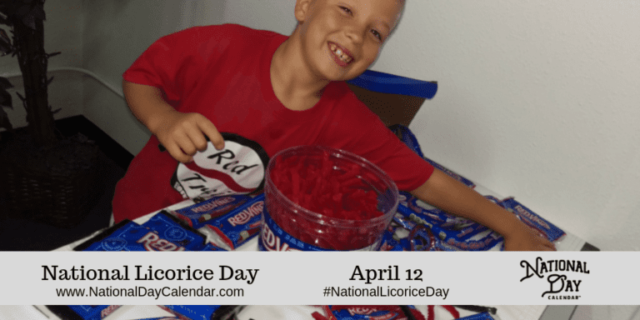
National Licorice Day is observed each year on April 12. This day was created to celebrate black licorice, its history, health benefits, and world renown. Enjoy black licorice in twists, stem shaped candies, licorice ropes, jelly beans, jewels, and many others.
- If you’re a fan of licorice and have noticed it makes your tummy feel better, there’s a reason. Licorice root can soothe a stomach bothered by heartburn or gastritis. The glycyrrhizic acid in licorice contains immune-boosting and anti-inflammatory properties that can help to restore balance to the stomach lining.
- The botanical name for licorice translates to “sweet root.”
- The licorice plant is actually a member of the pea family.
- This flavor is used in many products other than licorice candy, such as alcohol, tobacco, and of course food.
- Carbenoxolone, a compound derived from licorice root, may help slow the effects of aging on the brain.
- Licorice is not a recent discovery. The ancient Egyptians used it as a pharmaceutical, and copious supplies were found in King Tut’s tomb. Egyptian hieroglyphics record the use of licorice as a popular beverage among the men of the time.
- Manuscripts from 360 A.D. talk of licorice helping eye ailments, skin diseases, coughs, and loss of hair. Alexander the Great and Julius Caesar are on record as endorsing the benefits of eating licorice. Since the 14th century, it has been used to soothe coughs, colds, and bronchitis.
- Modern licorice candy dates back to 17th century Holland.
- The licorice plant, a shrub, is officially a weed. It is about four feet tall with purplish flowers and grows in hot, dry places.
- The ancient Greeks, Egyptians, Chinese, and Hindus recognized the natural medicinal qualities of licorice.
- Licorice root is a botanical ingredient in modern Chinese medicines used to manage cancers. Current research conducted at Rutgers, the State University of New Jersey, supports the use of licorice in the treatment of prostate and breast cancer.
- In the United States, anise seed is a popular substitute flavoring for licorice. Although the anise seed has an unmistakable licorice flavor, it is not related to the European plant whose roots are the source of true licorice.
- Napoleon Bonaparte found licorice soothing during battle; he allegedly ate so much of it that his teeth turned black.
- Salmiak or salmiakki is a type of licorice confectionery common in Germany, Finland, Sweden, and other Nordic countries. It’s flavoured with ammonium chloride, which gives it a salty flavour. It’s commonly referred to as “salty liquorice.”
- Here’s how to say licorice in 5 different languages: French: Regliss; German: Lakritze; Italian: Liquirizia; Spanish: Regaliz; Indian: Mulethi
- Licorice flavoring isn’t just used in candies. It’s also used in soft drinks and herbal teas.
- In the Middle Ages, Italian knights would use this romantic phrase to dedicate to the ladies they were sweet on: L’amore e’ un sogno, dolce come il latte e la liquirizia. What does it mean? “Love is a dream, sweet as milk and licorice.” How sweet!
- Root of licorice is used in the food industry for the production of candies, chewing gums and various liqueurs. Licorice is also popular and often consumed in the form of tea.
- Licorice helps relieve the pains that accompany certain types of ulcers, and it is good for the adrenal glands.
- Licorice is used as flavoring agent of tobacco and various types of beer and brandy.
- Thanks to foaming properties of this plant, root of licorice is used in the manufacture of foam for the fire extinguishers.
- Licorice was used for the preparation of healing tonic in the Ancient Egypt. This beverage was popular among Egyptian rulers. Famous pharaoh Tutankhamen was buried with large quantities of licorice.
- In Egypt the Pharaohs used liquorice to create a traditional drink called erqesos, which was consumed as a healing tonic.
- Licorice is popular as medicine worldwide. It can be used in treatment of respiratory tract disorders, cough, mouth and gastric ulcers, indigestion, headache and neurodegenerative disorders. Some medical studies indicate that licorice may be beneficial in treatment of certain types of cancer. Creams made of licorice can be used for the removal of the freckles and other discolorations on the skin.
- Large quantities of licorice may induce side effects such as edema, hypertension and hypokalemia.
https://youtu.be/GMHPldTxYjk
Sources:












